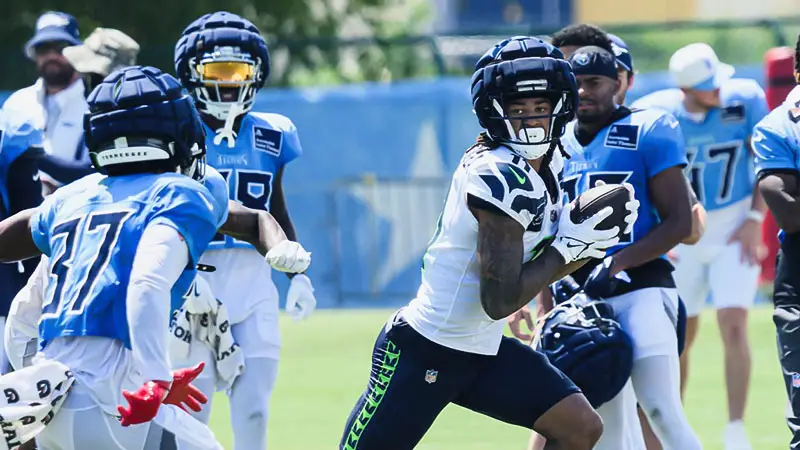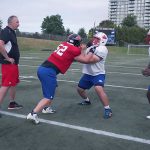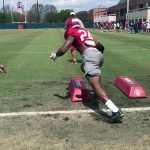NFL joint practices have become crucial in the preseason, offering teams a chance to enhance skills in a controlled, competitive environment. They break training camp monotony, introduce new competition and play styles, and better prepare players for the season.
These sessions develop camaraderie, allow real-time talent evaluation, and identify strengths and weaknesses that intra-squad scrimmages might miss.
They also reduce injury risks compared to preseason games, enabling strategic adjustments with balanced physical intensity.
By experimenting with new tactics against unfamiliar opponents, teams gain valuable insights, leading to dynamic and resilient performance. These practices also engage fans by providing a glimpse into player development and team dynamics.
Furthermore, the media coverage surrounding joint practices enhances team visibility and increases fan engagement, offering an inside look at preparation techniques and roster decisions.
This transparency helps build anticipation for the upcoming season, making joint practices an invaluable aspect of the NFL preseason.
Reasons for Joint Practices
Joint practices in the NFL serve multiple strategic purposes that contribute significantly to a team’s preparation for the season.
Increased Competition
Joint practices introduce players to varied competition. Facing opponents from different teams breaks the monotony of practicing against teammates daily. This fresh competition helps simulate the intensity and unpredictability of actual games.
Additionally, these practices offer coaches the opportunity to evaluate players in new matchups, identify areas for improvement, and enhance team chemistry. They also foster inter-team learning and collaboration.
Player Evaluation
Coaches use joint practices for player evaluation in real-time scenarios. They observe athletes in diverse situations, assessing performance against unfamiliar adversaries. This evaluation is critical, helping teams make informed roster decisions.
Additionally, joint practices promote strategic experimentation without game-day pressures, allowing coaches to test new plays and formations. The collaborative environment enhances overall team preparedness.
Preparation for Preseason Games
Joint practices are integral to preparing for preseason games. They offer a controlled environment where teams can implement and test game strategies. Practicing against different play styles prepares players for the variety of tactics they’ll face in competitive matches.
Additionally, joint practices help evaluate player performance under varied conditions, fostering growth and adaptability. This also builds camaraderie and allows coaches to identify strengths and weaknesses.
Building Team Chemistry
These sessions strengthen team chemistry and foster camaraderie. Joint practices encourage players to interact, collaborate, and support each other in a competitive setting. This helps build a cohesive unit, essential for success in the regular season.
Additionally, joint practices provide a valuable opportunity to assess players’ performance under different conditions. Coaches can evaluate their strategies against unfamiliar opponents, leading to improved game plans and adaptability.
How Do Joint Practices Work?
Joint practices involve coordinated sessions between two NFL teams. These sessions simulate game-like conditions, allowing teams to test different strategies and player capabilities.
Typical Schedule and Activities
Teams usually follow a structured schedule for joint practices. Sessions often span multiple days, including warm-ups, individual drills, and team drills. Coaches plan scrimmages and situational drills (e.g., goal-line stands).
These drills focus on specific scenarios teams might encounter during the season. Joint practices provide a unique opportunity to test strategies against unfamiliar opponents, enhancing player adaptability and on-field decision-making.
As a result, they contribute to both skill development and overall team cohesion.
Rules and Guidelines
Joint practices operate under a set of agreed-upon rules. These rules ensure safety and fairness. For example, full-contact drills are limited to minimize injury risk. Coaches from both teams establish guidelines for player conduct and practice intensity.
Officials may also attend to enforce rules similarly to a regular game. These practices provide a valuable opportunity for teams to simulate game environments, allowing players to test their skills against unfamiliar opponents.
Additionally, joint practices foster camaraderie and offer insights into different coaching styles and strategies.
Controlled Environment
A controlled environment characterizes joint practices. Coaches create scenarios tailored to test certain plays or player reactions. They control variables such as pace, intensity, and specific matchups.
This environment helps teams address weaknesses without the unpredictability of an actual game. By focusing on targeted situations, coaching staff can closely evaluate performance and make necessary adjustments.
Additionally, joint practices foster camaraderie and professional respect between teams, enhancing the competitive spirit.
Benefits of NFL Joint Practices
Joint practices offer several advantages that impact team performance significantly. They provide opportunities for development and strategy refinement.
Competitive Edge
Joint practices give teams a competitive edge by exposing them to unfamiliar opponents. Standard practices limit players to facing their teammates, while joint sessions introduce new challenges. This mimics real-game scenarios and requires quick adaptability.
NFL teams can analyze and counter various styles, ultimately preparing better for the season. Additionally, joint practices allow coaches to evaluate players in diverse situations, enhancing scouting and strategy formulation.
They also foster healthy competition and collaboration between teams, leading to mutual growth and learning.
Player Development
Player development accelerates during joint practices. Coaches can simulate different game situations, allowing players to respond in real-time, enhancing their skills. Rookies gain experience against non-teammates, building confidence and competence.
Repetition of these drills helps solidify techniques, providing valuable developmental feedback. Additionally, joint practices foster team camaraderie and expose players to varied playing styles, broadening their adaptability.
The competition boosts performance readiness, crucial for the upcoming season.
Team Chemistry
Team chemistry improves through joint practices as they foster collaboration and camaraderie. Players engage in dynamic communication and problem-solving. Coordinated drills enhance unit cohesion.
This camaraderie is crucial during the season, facilitating seamless execution of plays. Additionally, joint practices provide valuable exposure to different play styles and strategies.
This diverse experience helps players adapt more quickly to varied in-game scenarios, ultimately boosting overall performance.
Drawbacks of NFL Joint Practices
Though NFL joint practices offer numerous benefits, there are notable drawbacks that teams must consider.
Increased Risk of Injury
Joint practices elevate injury risk among players. Competitive drills and full-contact scrimmages increase the chances of collisions and muscle strains. When players face unfamiliar opponents, they might overexert, leading to unintended injuries.
According to a study by the Orthopaedic Journal of Sports Medicine, over 60% of injuries during joint practices are soft-tissue injuries.
Potential for Conflicts
Joint practices often lead to conflicts between teams. Aggressive behaviors during drills can escalate, resulting in fights. In 2021, several joint practices witnessed altercations, disrupting the training schedule and causing potential harm to players.
Frequent skirmishes can also sour relationships between teams, leading to lingering animosities during regular season matchups.
Notable Examples of NFL Joint Practices
Notable examples of NFL joint practices showcase how teams enhance preseason preparation. These sessions provide valuable insights into player performance, strategy refinement, and competitive readiness against varied opponents.
Patriots vs. Eagles
In 2014, the New England Patriots and the Philadelphia Eagles conducted joint practices. These sessions helped both teams evaluate rookies and veterans under competitive conditions, enhancing their preseason preparations.
Numerous reports noted improved team dynamics and valuable player assessments. Such practices also foster collaboration and expose players to different coaching styles.
As a result, the NFL continues to endorse joint practices for their strategic benefits and team-building opportunities.
Texans vs. Packers
The Houston Texans and the Green Bay Packers held joint practices in 2019. Players had the opportunity to face different opponents, providing a change of pace from the usual in-team drills.
The practices focused on situational football and individual matchups, benefiting player development. Additionally, joint practices help coaching staff identify key strengths and weaknesses in a more competitive environment.
These sessions also foster camaraderie and offer fans unique viewing experiences.
Rams vs. Chargers
In 2021, the Los Angeles Rams and the Los Angeles Chargers engaged in joint practices. These sessions allowed both coaching staffs to try out different strategies against unfamiliar schemes, offering a unique challenge for players.
Observers noted the competitive spirit and high energy levels throughout the practices. These joint practices also provided a controlled environment for assessing player performance under different conditions, enhancing preseason evaluation.
As a result, teams gain valuable insights that inform roster decisions.
49ers vs. Broncos
The San Francisco 49ers and the Denver Broncos held joint practices in 2016. These sessions helped both teams to work on specific game scenarios, such as red-zone and two-minute drills.
Coaches emphasized the benefits of seeing how their players responded to different defensive and offensive styles.
Additionally, joint practices allow teams to evaluate their player’s adaptability and skills against unfamiliar opponents, providing a unique preparation that regular intra-team practices cannot offer.
Cowboys vs. Raiders
In 2021, the Dallas Cowboys and the Las Vegas Raiders participated in joint practices. These encounters were marked by intense physicality and tactical drills that tested the resilience and adaptability of players.
Analysts pointed to the value gained from these highly competitive sessions, despite occasional conflicts. Such practices also provide coaches with a unique opportunity to evaluate their team’s performance against different styles of play.
Additionally, they allow for better strategic adjustments ahead of the regular season.
Frequently Asked Questions
What are the benefits of NFL joint practices?
NFL joint practices help players improve their skills, allow coaches to evaluate talent, and build team chemistry. They also create opportunities for practicing specific game scenarios and enhance competitiveness through varied matchups and strategies.
What are the drawbacks of NFL joint practices?
The main drawbacks include an increased risk of injuries and potential conflicts or fights between teams. The added physical and emotional demands can sometimes outweigh the benefits.
Can you give examples of notable NFL joint practices?
Some notable NFL joint practices include the Patriots and Eagles in 2014, Texans and Packers in 2019, Rams and Chargers in 2021, 49ers and Broncos in 2016, and Cowboys and Raiders in 2021. These sessions have been crucial for player evaluation and strategy implementation.
How do joint practices enhance player evaluation?
Joint practices provide a controlled environment where coaches can assess players’ performance against different opponents. This helps identify strengths and weaknesses, making it easier to refine rosters and strategies before the season starts.
Do joint practices improve team competitiveness?
Yes, they do. By facing different teams, players and coaches experience varied strategies and playing styles. This exposure helps teams prepare better for the diverse competition they’ll face throughout the season.
Conclusion
NFL joint practices offer a unique blend of benefits and challenges. They provide an invaluable opportunity for skill enhancement, thorough player evaluation, and fostering team chemistry.
The notable examples of joint practices over the years underscore their importance in preparing teams for the season.
Despite the risks of injury and potential conflicts, these sessions remain a crucial aspect of NFL training, helping teams refine strategies and boost competitiveness.
Ultimately, the advantages of joint practices make them an essential component of the NFL’s preseason regimen. Additionally, joint practices allow for direct competition against different playing styles, which can uncover weaknesses and areas for improvement.
By practicing against varied opponents, teams can better adapt to diverse in-game scenarios, thereby enhancing their overall preparedness for the regular season.








Ashley Hopkinson